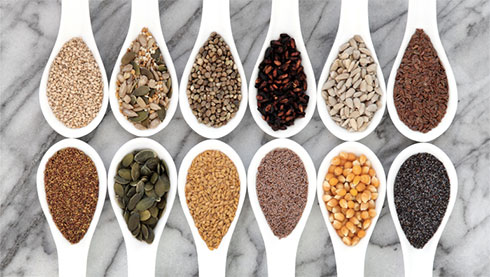
Ever since the paleo diet gained popularity, seeds have had a new and profound role in our diet. What was once looked at as a garnish or snack food has now been found to be an essential addition to our diets to reap the benefits they have to offer. Today we’ll be taking a look at the different small but mighty seeds that you can include in your diet to get the much needed nutritional boost.
Chia – we can’t talk about seeds without mentioning the infamous chia seeds. Believe it or not, chia seeds actually come from the mint plant family. What makes chia seeds so versatile is their ability to absorb almost 10 times their weight, therefore they have become a great thickening agent to add to foods like puddings, pancakes or even shakes. Let’s take a look at what makes this seed a number 1 superfood (nutrition facts provided for 1 ounce/28g/2 tablespoons):
Rich in manganese, magnesium, phosphorus and calcium this tiny seed is a great addition to your daily dietary habits. I would personally add it to water sometimes (but drink up quick or else it’ll form a thick gel), green juices, and salads. Weight loss capabilities of this seed have not been scientifically proven!
Flax – this super oily seed is rich in omega 3’s, fiber Vitamin B1, copper and magnesium. Definitely a must add to your daily eating habits. Flax seeds should be ground before consuming, but do keep in mind that it is a seed rich in fats therefore it can go rancid if ground and not refrigerated. Let’s take a look at the nutritional profile of flax seeds (per 1 ounce/28 grams/4 tablespoons):
Looking at the nutritional profile, you can see that the flax seed contains more fats that the chia seed yet almost the same amount of omega 3’s; making the chia seed a greater source of omega 3’s with lesser calories.
Sesame – very commonly used in our region, yet I for sure never thought twice about the nutritional benefits of this mighty seed. Sesame seeds are rich in calcium, great for your bones and migraines, and zinc, an immune system booster! Definitely worth thinking twice about, before skimping on the zaatar mix or bread with sesame seeds. As for it’s nutritional profile for 1 ounce/28 grams/2 tablespoons, the following is what sesame seeds have to offer:
Compared to the previous two seeds, sesame seeds are the fattiest so far, but still has a decent amount of protein in it. Sesame seeds stand out with their iron content, one of the richest seeds in iron, I highly recommend it for vegetarians suffering from anemia.
Pumpkin – who would’ve thought that this nutritious vegetable would also have very nutritious seeds? How nutritious? Let’s start by saying that pumpkin seeds are loaded with zinc and manganese, which have huge effects on helping boost your immune system, bone health and possibly help control blood sugar (to a certain degree of course). Looking at the nutritional facts, pumpkin seeds have the following to offer (1 ounce/28 grams/2 tablespoons):
All those seeds provide us with various forms of antioxidants, minerals, fiber, protein and healthy fats! You cannot go wrong by adding them to your diet, just be sure to control your portion by measuring out how the amount you’d like to eat. I love adding them to salads or my oatmeal and my green juice at times. How would you add those seeds to your food?
Post by Hyatt Al Sayegh, a Clinical Dietitian and Dr. Sears Health Coach.
Founder of Fork Fed.
Image Source

11 replies on “Fork Fed: Superfood – Seeds”
Just to touch up on your flax & chia points, you neglected to mention that conversion rates of ALA to EPA & DHA are fairly low.
EPA and DHA are simply way more bioavailable.
Conversion rates from the phyto sourced omega 3s tend to be very low. In fact women have a higher conversion rate than men, the highest conversion rates of up to 20% are found in pregnant women.
Just thought id add that to your post, with all due respect to your fine efforts.
my background:
Medical herbalist
Thank you very much!
Great info and simple to digest, thanks.
I know banek is not a seed per-se, but do you have any info on it Hyatt?
https://248am.com/mark/kuwait/what-is-banak/
Seaweed seeds supposedly
Thanks Mark!
Hello Kuwait Chronicles,
Unfortunately I have no clue. I’ve been asked by many people but can’t seem to find any reliable source with information. I’ll keep asking and let you know 🙂
It’s still a little unclear what exactly banak is, but your post does help.
I’ve asked Bulgarians about the banak bulghari, but they have no clue.
Was wondering if anyone had analysed it for nutritional value.
As far as I know, no Kuwaiti government agency has analysed the nutritional value. I’m on a mission to find out though, will keep you posted.
Thanks Hyatt!
the pumpkins seed protein value seems way off 10g of protein per 28g gram serving ? and 14g of fat ? seems like there is something wrong
Hello gargoyle,
Thanks for your comment, I should’ve specified that I was talking about unshelled raw pumpkin seeds. I know, it does seem like a lot for pumpkin seeds.
For more information you can check out:
https://ndb.nal.usda.gov/ndb/foods/show/3616?manu=&fgcd=
https://nutritiondata.self.com/facts/nut-and-seed-products/3066/2
I usually take an average of the nutrition values I find just because there are many factors that can contribute to a slight difference in nutritional values.
I hope this helps!